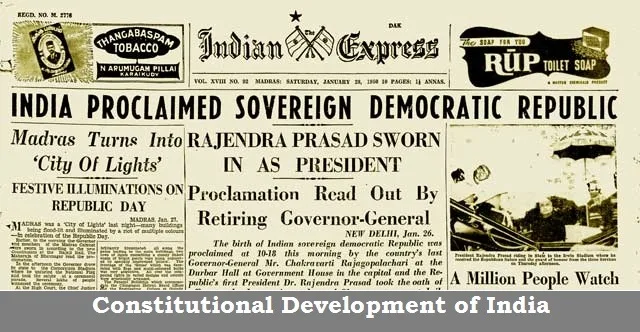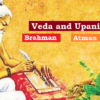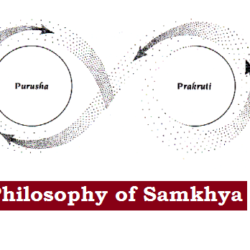
Background
- 1765 East India Company obtained ‘Diwani’ (revenue and civil rights) and company rule started in India.
- There were many steps taken to administer and regulate company affairs in India and Britain by the British Parliament through Regulating Acts and Charter Acts.
- After ‘Sepoy Mutiny’, Company was abolished and all the powers were transferred to the British Crown.
- Gradually decentralization of power from center to provinces started with many experiments and steps taken to establish a responsible govt in the center as well as in provinces.
- Constituent Assembly was established in 1946 to draft a Constitution for India. British Rule and certain events of the time provided the legal framework for the organisation and administration of Indian Govt after independence.
Here are some of the important Regulations and Acts:
Centralization of Power
1. Regulating Act (1773): First step to control and regulate Company affairs
- Gov-Gen of Bengal designated (Lord Hastings being the first)
- Other presidencies subordinate to him
- Board of Directors to report to British Govt
2. Pitt’s India Act (1784): To rectify the defects, (Act of Settlement)
- Company’s territory called ‘British Possessions’
- Commercial (Board of Directors) and Political (Board of Control) Affairs separated (Double Govt)
- BoC to superintendent and direct all operation (Parliamentary Control)
3. Charter Act (1833): Final step towards centralization (Central Authority)
- Gov- Gen of Bengal became that of India with exclusive powers (William Bentick being the first) (Govt of India initiated)
- EIC activities as a purely administrative body, commercial body ended
- Open Competition for civil service initiated but aborted due to opposition from the company
Decentralization initiated
4. Charter Act 1853:
- Executive and legislative functions of Gov- Gen separated
- 6- member Legislative Council as Mini- Parliament
- 4 members to be appointed by provinces
- Open competition for civil service started
5. Govt of India Act 1858: Direct British rule started and steps taken for good governance
- Gov- Gen designated as Viceroy as the direct representative of the Crown (Lord Canning being the first)
- New office of Secretary of State created abolishing BoD, and BoC
- 15- member council to assist him, it was an advisory body
Indians in Govt, further Decentralization
6. Indian Council Act 1861: Through many acts Indians were taken in confidence
- Indians to be nominated as non- official members to Viceroy’s extended Council
- Legislative powers of Madras and Bombay restored
- Legislative Councils for Provinces started (Bengal, NWFP, Punjab)
- Portfolio system started (in- charge for a dept)
- Ordinance power to the Viceroy during emergency
7. Indian Council Act 1892:
- Legislative Council empowered to discuss Budget
- Some Non- official Indian members to be nominated on the recommendation
- Provincial Govt and Local Bodies (to Provincial Govt) (Indirect elections for the first time)
8. Indian Council Act 1909: (Morley- Minto Reforms), elections introduced
- Size of Legislative Councils increased with enlarged deliberative functions (supplementary questions, move resolutions, etc)
- Indians to the Executive Council of Viceroy (Satyendra Prasad Sinha being the first)
- Introduced elections on the basis of ‘Separate Electorate’ for Muslims, Corporations, Zamindars, Universities (Legalized Communalism)
Responsible Govt
9. Govt of India Act 1919 (Montague- Chelmsford Reforms): Provincial Councils empowered
- Central control relaxed over provinces by separating central and provincial subjects
- Transferred (by Councils) and Reserved Subjects in Provinces (by Governor) (“Dyarchy System“)
- Bicameralism started in many states with majority of members to be directly elected
- 3 of the 6 members in Viceroy’s Executive Council to be Indians
- Communal Representation extended to Sikhs, Christians, Anglo- Indians and Europeans
- Franchise to a limited population based on property, tax and education
10. Govt of India Act 1935: Elaborate responsible governance, culmination of Simon Commission Report, Round Table Conference
- All India Federation established consisting of provinces and princely states
- Divided the powers in terms of Federal List, Provincial List and Concurrent List with Residuary powers to the Viceroy (Federation never came as Princely states disagreed)
- Abolished dyarchy in the provinces, governor was to act on the advice of ministers
- Recommended Dyarchy for the center (not implemented)
- Separate electorate for depressed classes (SCs) and women and workers
- Federal and Provincial Public Service Commissions, RBI, Federal Court established
11. Indian Independence Act 1947: Independence
- Independent dominion with right to secede from British Commonwealth
- Gov- Gen to be appointed by the King on the advice of dominion cabinet
- Gov- Gen with full power to assent to any bill in the name of His Majesty, he with governors were to act on the advice of council of ministers

 Home
Home Syllabus
Syllabus Contact Us
Contact Us








